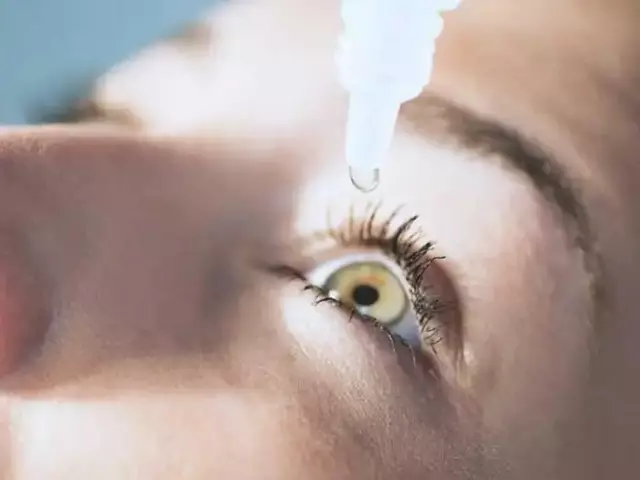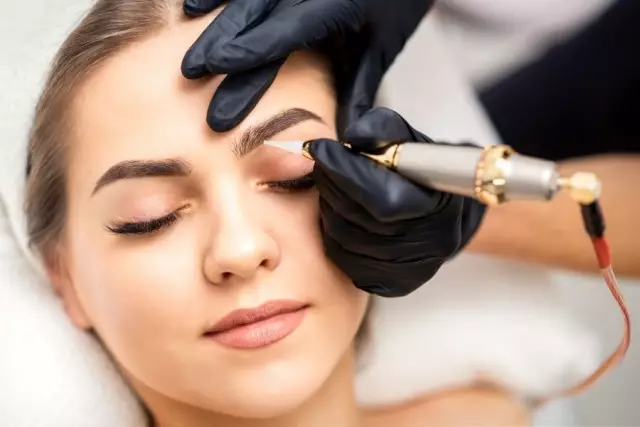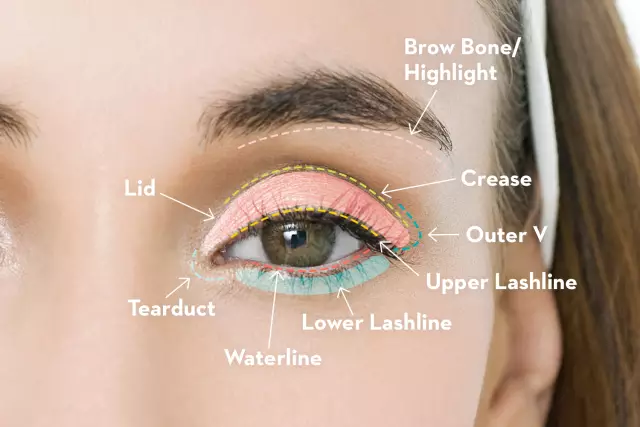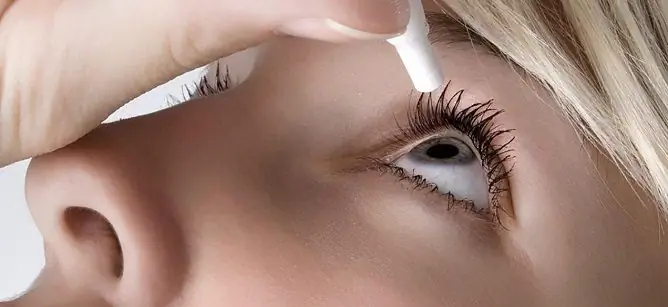- Author Rachel Wainwright [email protected].
- Public 2023-12-15 07:39.
- Last modified 2025-11-02 20:14.
Olopatallerg
Olopatallerg: instructions for use and reviews
- 1. Release form and composition
- 2. Pharmacological properties
- 3. Indications for use
- 4. Contraindications
- 5. Method of application and dosage
- 6. Side effects
- 7. Overdose
- 8. Special instructions
- 9. Application during pregnancy and lactation
- 10. Use in childhood
- 11. In case of impaired renal function
- 12. For violations of liver function
- 13. Use in the elderly
- 14. Drug interactions
- 15. Analogs
- 16. Terms and conditions of storage
- 17. Terms of dispensing from pharmacies
- 18. Reviews
- 19. Price in pharmacies
Latin name: Olopatallerg
ATX code: S01GX09
Active ingredient: olopatadin (Olopatadine)
Manufacturer: K. O. Rompharm Company S. R. L. (SC Rompharm Company SRL) (Romania)
Description and photo update: 2019-17-10
Prices in pharmacies: from 305 rubles.
Buy

Olopatallerg - antiallergic agent for topical use in ophthalmology; blocker of H 1 -histamine receptors.
Release form and composition
The drug is available in the form of eye drops 0.1%: a transparent, colorless liquid (in white polymer dropper bottles of 5 ml, each bottle is sealed with a polymer cap with a safety ring; 1 dropper bottle).
Composition of 1 ml drops:
- active ingredient: olopatadin - 1 mg (in the form of olopatadine hydrochloride - 1.1 mg);
- additional components: benzalkonium chloride - 0.1 mg; sodium chloride - 6.5 mg; disodium phosphate dodecahydrate - 12.5 mg; 1M hydrochloric acid solution or 1M sodium hydroxide solution - to pH 7.1 ± 0.1; purified water - up to 1 ml.
Pharmacological properties
Pharmacodynamics
Olopatadine is a potent selective antihistamine / antiallergic agent. Its pharmacological effects are mediated through several different mechanisms of action. It is an antagonist of histamine, which is the main mediator of allergic reactions in humans. Olopatadine interferes with the histamine-induced release of inflammatory cytokines in the epithelial cells of the conjunctiva. According to the results of in vitro studies, it can be assumed that the inhibition of the release of proinflammatory mediators by mast cells of the conjunctiva.
With topical application of olopatadine in the form of instillations into the conjunctival sac in patients with patent nasolacrimal ducts, the severity of nasal symptoms, which often accompany seasonal allergic conjunctivitis, decreased.
There was no clinically significant effect of olopatadine on pupil diameter.
Pharmacokinetics
The main pharmacokinetic parameters of olopatadin:
- absorption: olopatadine, like other topical drugs, undergoes systemic absorption, but its plasma concentrations after topical application in ophthalmology are low and range from <0.5 (which is below the level of quantitation) to 1.3 ng / ml. For example, with oral administration of olopatadine in therapeutic doses, the plasma concentration will be 50-200 times higher;
- excretion: T 1/2 (half-life) of the active substance, according to pharmacokinetic studies of oral forms of olopatadine, varies in the range of 8-12 hours. The drug is excreted mainly in the urine, unchanged - 60-70% of the administered dose. In urine, two metabolites of olopatadin are also present in low concentrations - n-oxide and mono-desmethyl.
Pharmacokinetic parameters of olopatadine in special groups of patients:
- patients with impaired renal function: since the main part of the taken dose of the drug is excreted by the kidneys unchanged, impairment of their function affects the pharmacokinetics of olopatadine, significantly (2.3 times) increasing its plasma concentration in patients with severe renal failure [with CC (clearance creatinine) 13 ml / min]. However, with topical administration of olopatadine (in the form of instillations), its plasma concentration is 50-200 times lower than that of oral administration in therapeutic doses; therefore, it is not required to change the dosage regimen for impaired renal function. During the hemodialysis procedure, the concentration of olopatadine in the plasma decreases (in patients on hemodialysis after taking 10 mg of olopatadine orally);
- patients with impaired hepatic function: since the hepatic elimination pathway for olopatadine is not the main one, it is not required to adjust the dose of the drug in case of impaired liver function;
- elderly patients: since with topical administration of olopatadine (in the form of instillations) its plasma concentration is 50-200 times lower than that of oral administration in therapeutic doses, there is no need to change the dosage regimen for elderly patients. When conducting comparative studies of the pharmacokinetics of an oral dosage form of olopatadine at a concentration of 10 mg in elderly patients, whose average age was 74 years, and young patients, whose average age was 21 years, no significant differences were found in binding to plasma proteins, plasma concentrations of olopatadine, parameters of excretion of the drug in the form of metabolites and unchanged.
Indications for use
Olopatallerg eye drops are intended to treat the symptoms of seasonal allergic conjunctivitis.
Contraindications
Absolute:
- children under 3 years old;
- period of pregnancy;
- lactation;
- hypersensitivity to olopatadin or other components in the composition of drops.
Relative (Olopatallerg is used with caution): corneal diseases, dry eye syndrome.
Olopatallerg, instructions for use: method and dosage
Olopatallerg eye drops are intended for topical use.
Instillation of the solution is performed into the conjunctival sac of the affected eye, observing an interval of 8 hours between instillations.
Recommended dosage: 1 drop 2 times a day.
The duration of therapy can be up to 4 months.
If necessary, Olopatallerg can be used in combination with other ophthalmic agents, maintaining an interval of at least 5 minutes between their administration.
In patients with renal / hepatic insufficiency and the elderly, there is no need to adjust the dosage regimen.
In children over 3 years old, Olopatallerg is used in doses similar to those for adult patients.
It is necessary to tightly close the lid of the dropper bottle after using the product. Contact of the tip of the bottle with the eye, skin of the eyelids or any other surface is highly undesirable, as it can lead to contamination of the contents of the bottle.
Side effects
When conducting clinical studies in patients (in the amount of 1680 people) who used olopatadine at a dosage of 1-4 drops for up to 4 months as a monotherapy, as well as together with loratadine at a dosage of 10 mg, adverse reactions occurred in 4.5% of cases. In only 1.6% of patients, this led to discontinuation of participation in the clinical trial. Serious side effects were not observed either from the organ of vision or from the body as a whole. Most often, study participants complained of discomfort in the eye, this disorder was recorded in 0.7% of patients.
Adverse reactions noted during clinical trials and during the period of post-registration use of Olopatallerg from organs and systems of the body [are grouped according to the following gradation of frequency of occurrence: very often (≥ 1/10); often (from ≥ 1/100 to <1/10); infrequently (from ≥ 1/1000 to <1/100); rarely (from ≥ 1/10 000 to <1/1000); very rare (<1/10 000); with an unknown frequency (the frequency of occurrence cannot be determined based on the available data)]:
- organ of vision: often - unusual sensations in the eye, irritation of the conjunctiva, pain in the eye, dry eye syndrome; infrequently - accumulation of coloring pigment in the area of the corneal defect during diagnostic tests, corneal epithelial defect, itching in the eye, keratitis, punctate keratitis, eyelid edema, erythema of the eyelids, eye discharge, corneal erosion, blurred vision, lacrimation, decreased visual acuity, blepharospasm, eyelid disorders, eye discomfort, conjunctival folliculosis, photophobia, conjunctival disorders, conjunctival injection, foreign body feeling in the eye; with an unknown frequency - crusts on the edges of the eyelids, mydriasis, visual impairment, corneal edema, conjunctival edema, conjunctivitis;
- respiratory system: often - a feeling of dryness in the nose; infrequently - rhinitis; with an unknown frequency - sinusitis, dyspnea;
- nervous system: often - dysgeusia, headache; infrequently - hypesthesia, dizziness; with an unknown frequency - drowsiness;
- immune system: with an unknown frequency - swelling of the face, hypersensitivity to the components that make up Olopatallerg;
- digestive tract: with an unknown frequency - vomiting, nausea;
- skin and subcutaneous fat: infrequently - burning sensation of the skin, contact dermatitis, dry skin; with an unknown frequency - erythema, dermatitis;
- other reactions: often - increased fatigue; with an unknown frequency - a feeling of malaise, asthenia.
Against the background of the use of drops, which contain phosphate, in patients with concomitant significant damage to the cornea, corneal calcification rarely developed.
Overdose
There is no information on cases of Olopatallerg overdose when it is accidentally swallowed or introduced into the conjunctival cavity in an amount exceeding the recommended dose.
If undesirable reactions appear against the background of accidental ingestion of drops, symptomatic and supportive therapy is prescribed.
special instructions
Despite the fact that Olopatallerg is an antihistamine / antiallergic drug for topical use, its active component, olopatadine hydrochloride, is absorbed into the systemic circulation. If the use of drops caused the appearance of severe hypersensitivity reactions, it is necessary to immediately interrupt drug therapy.
The drug contains benzalkonium chloride, which can be adsorbed by soft contact lenses and irritate the eyes. Before instilling the solution, contact lenses should be removed and reinstalled no earlier than 15 minutes after the procedure.
Due to the benzalkonium chloride contained in the drops, in patients with corneal pathology or dry eye syndrome, frequent or prolonged use of Olopatallerg can lead to the development of toxic ulcerative keratopathy or punctate keratitis.
Influence on the ability to drive vehicles and complex mechanisms
The use of Olopatallerg does not significantly affect the cognitive functions of a person and his ability to drive vehicles and work with complex mechanisms. However, in the first minutes after instillation of drops, blurred vision is possible, therefore, before proceeding with activities that require clarity of visual perception (driving a car, etc.), it is necessary to wait for the complete restoration of visual functions.
Application during pregnancy and lactation
In the process of studies carried out on animals, the toxic effect of olopatadine on reproductive function was revealed with its systemic use.
There is no information about the local use of Olopatallerg drops in pregnant patients, or they are limited, therefore, it is contraindicated to use the drug during gestation.
For women of childbearing age who do not use reliable methods of contraception, the use of an ophthalmic agent is also not recommended.
Experiments on animals have shown that olopatadin passes into breast milk. Since the associated risk for the child cannot be completely excluded, Olopatallerg is contraindicated for women who are breastfeeding.
The effect of olopatadine on human fertility when applied topically in ophthalmology has not been studied.
Pediatric use
Olopatallerg drops are contraindicated for pediatric patients under 3 years of age.
In children over 3 years old, the drug is used in the same doses as in adults.
With impaired renal function
Separate studies on the use of Olopatallerg in patients with impaired renal function have not been conducted.
The need for dose adjustment in this category of patients is not expected.
For violations of liver function
Separate studies on the use of Olopatallerg in patients with impaired liver function have not been conducted.
The need for dose adjustment in this category of patients is not expected.
Use in the elderly
Elderly people do not need to make changes in the dosage regimen of Olopatallerg.
Drug interactions
There are no data on the interaction of olopatadine with other drugs.
In vitro studies have demonstrated the absence of inhibition of metabolic reactions mediated by isoenzymes of the cytochrome P 450 system CYP3A4, CYP2C8, CYP1A2, CYP2D6, CYP2E1, CYP2C9 and CYP2C19. The results obtained in the course of studies indicate a low probability of the entry of olopatadine into metabolic reactions when used simultaneously with other drugs.
Analogs
Olopatallerg analogues are Visallergol, Opatanol, Oloftadin ECO, etc.
Terms and conditions of storage
Keep out of the reach of children. Store in a place protected from sunlight.
Storage temperature should not exceed 25 ° C.
The shelf life is 3 years.
An opened bottle with drops must be used within 28 days.
Terms of dispensing from pharmacies
Dispensed by prescription.
Reviews about Olopatallerg
Patients leave good reviews about Olopatallerg, eye drops for the treatment of seasonal allergic conjunctivitis. According to users, when the solution is instilled into the conjunctival sac, there is no burning sensation, no discomfort, pain and itching in the eyes disappears. Patients consider the long (practically within a day) effect of the drug, as well as the absence of any irritation or side effects during its use, a positive moment.
The disadvantage of an ophthalmic drug, many users call it a rather high cost.
Price for Olopatallerg in pharmacies
The price of Olopatallerg, eye drops 0.1%, for 1 dropper bottle of 5 ml, varies from 300 to 506 rubles.
Olopatallerg: prices in online pharmacies
|
Drug name Price Pharmacy |
|
Olopatallerg 0.1% eye drops 5 ml 1 pc. 305 RUB Buy |
|
Olopatallerg eye drops 0.1% 5ml RUB 360 Buy |

Anna Kozlova Medical journalist About the author
Education: Rostov State Medical University, specialty "General Medicine".
Information about the drug is generalized, provided for informational purposes only and does not replace the official instructions. Self-medication is hazardous to health!






